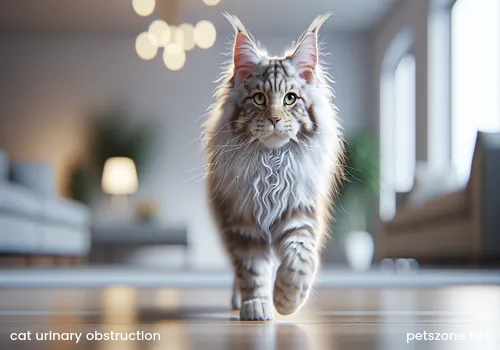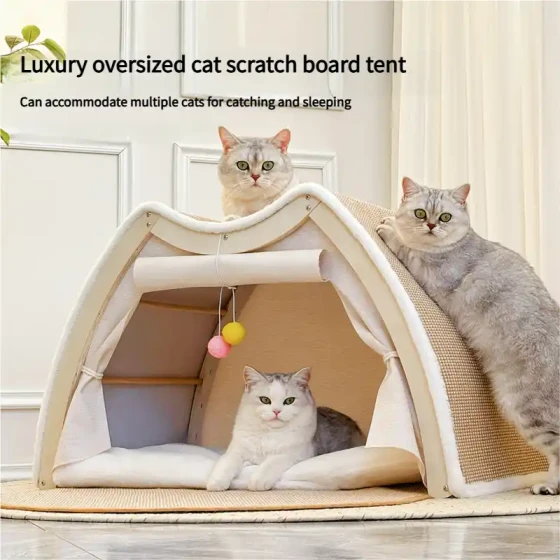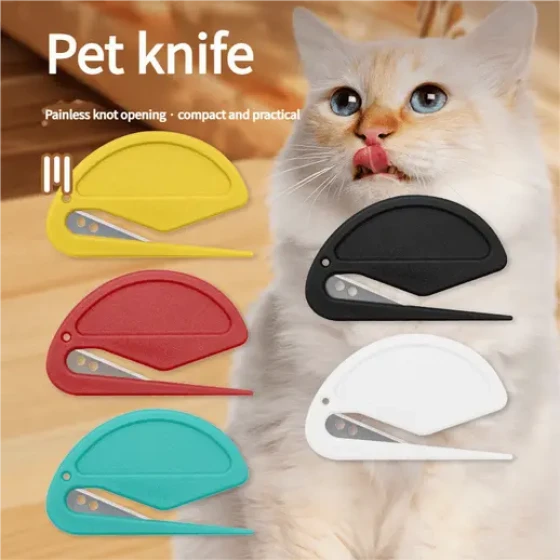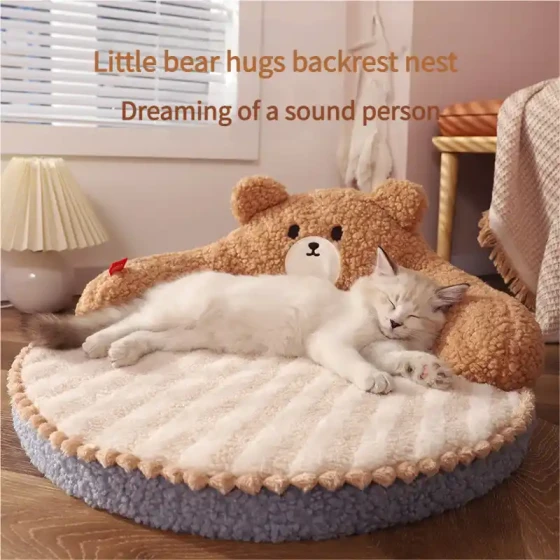Pet Cat Urinary Obstruction_Reasons and Responses to Cat Urination Difficulties
Cat urinary obstruction, i.e., blockage of the cat's urethra due to various reasons, prevents normal urination. This is an urgent medical condition needing immediate intervention. If you notice your cat frequently entering and leaving the litter box, adopting a urination posture without producing urine, vocalizing in pain, abdominal swelling, or lethargy, it is highly likely urinary obstruction; please take it to the vet immediately as persistent obstruction can cause kidney damage and be life-threatening.

Cat Urination Difficulty: Signals Not to Ignore
Urination behavior is an important "barometer" of your cat’s health. Once abnormalities such as difficulty urinating appear, owners should be alert. This is not just a minor inconvenience but possibly an urgent distress signal from your cat’s body.
Common Symptoms:
* Frequent visits to the litter box with very little or no urine output. Some cats repeatedly squat trying to urinate but only produce a few drops or none at all.
* Painful vocalizations during urination. Urinary obstruction causes intense pain; cats may emit low whimpering or sharp howls.
* Urinating outside the litter box. Due to pain and discomfort, cats may attempt to urinate in places they usually avoid, such as carpets or beds.
* Excessive licking of the genital area. This indicates discomfort.
* Abdominal tenderness or swelling on palpation. A full bladder causes abdominal tension and swelling; touching may induce resistance or pain.
* Lethargy, loss of appetite, or even vomiting. As the condition worsens, toxins accumulate causing systemic distress.
* Weakness and unsteady gait. Severe obstruction can cause electrolyte imbalance leading to weakness.
Notably, male cats are more prone to urethral blockage because of their narrower urethra, and their condition progresses faster and is more dangerous. If you notice these symptoms in a male cat, treat it as an emergency without delay.
Investigating the Culprits Behind Cat Urination Difficulties
Urination difficulties, especially obstruction, are rarely caused by a single factor but usually result from a combination known as feline lower urinary tract disease (FLUTD). These culprits include but are not limited to:
1. Urolithiasis (Urinary Stones)
These are like "small stones" in a cat's urinary system. They form from mineral crystals precipitating in urine, commonly struvite and calcium oxalate stones.
* Causes: Mainly related to diet (high magnesium and phosphorus), insufficient water intake, urine pH (too acidic or alkaline), genetics, and some infections.
* Harm: Small stones may pass with urine, but large or many stones may block the urethra causing obstruction or irritate the bladder wall causing inflammation and pain.
2. Feline Idiopathic Cystitis (FIC)
Also called spontaneous cystitis, FIC is inflammation of the bladder without a clear cause but often related to stress and environmental changes.
* Triggers: Moving house, new family members, dirty litter boxes, multi-cat conflicts, lack of play and interaction are all potential stress sources.
* Signs: Bladder wall inflammation and swelling cause painful urination, blood in urine, frequent but small urination, and possibly urethral spasms causing functional obstruction. It is a condition influenced by both "mind" and "body," sometimes humorously dubbed the cat’s "glass heart bladder."
3. Urethral Plugs
This is the most common direct cause of urinary obstruction in male cats. Urethral plugs form from protein matrix, inflammatory cells, blood cells, and small crystals or stone fragments creating a "cork" blocking the urethra.
* High-risk group: Neutered male cats, because their urethras are longer and narrower than females.
4. Urinary Tract Infection (UTI)
Microorganisms such as bacteria, viruses, or fungi invade the urinary tract causing inflammation.
* Features: UTIs are less common as a primary cause of obstruction in young cats but are more frequent in older cats or those with other conditions like diabetes or kidney disease. Infections cause inflammation and pain leading to urination difficulty.
5. Other Rare Causes
- Tumors: Urinary system tumors (e.g., bladder tumors) may block or compress the urethra causing difficulty urinating.
- Nervous System Issues: Spinal injuries or other neurological diseases can affect normal bladder contractions and urination.
- Congenital Abnormalities: A very few cats may have structural defects in the urinary system from birth.
Emergency Response and Professional Treatment
If you notice signs of urinary obstruction at home, take your cat to the vet immediately! Do not try to manually express the bladder or use any medication at home; this may cause bladder rupture or delay optimal treatment.
Upon arrival, veterinarians usually perform the following treatments:
- Emergency catheterization: This is the key step to relieve obstruction. The vet inserts a catheter to push the blockage back into the bladder or remove it directly to drain accumulated urine, alleviating pain and protecting kidney function. Sedation or anesthesia may be required.
- Fluid therapy: Intravenous fluids help correct dehydration, electrolyte imbalance, and promote kidney recovery.
- Medication treatment:
- Painkillers: To relieve the cat’s severe pain.
- Anti-inflammatory drugs: Reduce bladder and urethral inflammation.
- Sedatives/muscle relaxants: Help relax the urethra for easier catheterization.
- Antibiotics: If bacterial infection is present.
- Follow-up diagnostics: After catheterization, vets conduct detailed examinations to identify causes:
- Urinalysis: Detect red and white blood cells, crystals, bacteria, etc.
- Blood tests: Assess kidney function, electrolytes, and systemic inflammation.
- Imaging exams: X-rays or ultrasounds to find stones, tumors, or structural issues.
Cost estimate: In China, emergency catheterization and hospitalization fees vary by region and hospital level, usually ranging from several hundred to several thousand RMB. Surgery or long-term management increases costs.
Long-term Management and Prevention: Keeping Cats Away from “Heartbreaking” Troubles
Cat urinary obstruction often recurs, so post-discharge long-term management and prevention are crucial. It is like a “protracted battle” requiring patience and care from owners.
1. Dietary Management: The Foundation of Urinary Health
- Primarily wet food: Increasing water intake is key to preventing urinary problems. Wet food (canned, meat pate, etc.) contains much more moisture than dry food, effectively diluting urine and reducing crystal formation. If your cat usually eats dry food, try gradually transitioning to wet food or soften dry food with water.
- Prescription diets: For cats with a history of stones or idiopathic cystitis, vets may recommend special urinary prescription diets that regulate urine pH, dissolve or prevent certain stones, and include bladder-friendly ingredients.
- Weight control: Obesity increases the risk of urinary tract diseases.
2. Increase Water Intake: A Gentle Stream Moisturizes the Bladder
- Multiple water sources: Provide several water points using ceramic or glass bowls to avoid odors from plastic.
- Running water: Many cats prefer flowing water; consider purchasing a pet fountain to encourage drinking.
- Add fun: Try adding small amounts of catnip or unsalted chicken broth to water to increase attractiveness.
3. Environmental Improvement: Stress Relief is the Best Medicine
- Clean litter boxes: Clean at least once daily to keep dry and tidy. Cats are clean animals and dirty litter boxes discourage urination.
- Adequate number of litter boxes: Recommended number = number of cats +1, placed in quiet, private, and easily accessible locations.
- Enriched environment: Provide scratching posts, cat trees, hiding places, interactive toys to reduce boredom and stress.
- Reduce stressors: Avoid frequent home environment changes, loud noises, or sudden introduction of new pets.
4. Regular Check-ups: Prevention is Better Than Cure
- Take cats for a full physical exam and urinalysis annually to detect potential problems early.
- Cats with a history of obstruction should have more frequent follow-ups as per the vet’s advice.
5. Observe Urination: Daily Homework Not to Forget
- Monitor frequency, volume, and color of urine. If abnormalities appear, consult a vet promptly.
- Use highly absorbent litter to facilitate urine volume observation.
Frequently Asked Questions
Q1: Can cat urinary obstruction heal by itself?
A1: No. It is an emergency that cannot resolve spontaneously and requires immediate professional treatment. Delaying treatment threatens life.
Q2: Which is more prone to urinary obstruction, male or female cats?
A2: Male cats are more susceptible. Their urethras are longer and narrower, making blockage from crystals, plugs, or inflammation more likely.
Q3: Does cat urinary obstruction always require surgery?
A3: Not necessarily. Most cases are resolved by catheterization. However, recurrent obstruction unresponsive to medical treatment may require urethrostomy surgery to widen the urethra and reduce recurrence risk.
Q4: What to do if my cat doesn't like drinking water?
A4: Try offering wet food, flowing water (pet fountains), multiple water bowls, adding small amounts of catnip or unsalted chicken broth, and ensure the water bowl is clean with fresh water.
Q5: Is urinary obstruction equivalent to kidney failure?
A5: Urinary obstruction can cause acute kidney injury or failure but is not the same. Early relief usually restores kidney function; prolonged obstruction causes irreversible damage.
Conclusion
Though cat urinary obstruction sounds frightening, careful observation, early detection, and prompt veterinary care can save most cats effectively. More importantly, through scientific diet, good environmental management, and regular health checks, we can greatly reduce the risk of this "heartbreaking" disease, allowing cats to enjoy a healthy and happy life.
References
- Based on descriptions of feline lower urinary tract disease in the Merial Veterinary Manual.
- International Society of Feline Medicine (ISFM) guidelines on feline lower urinary tract disease.
- American Animal Hospital Association (AAHA) recommendations on feline urinary system diseases diagnosis and treatment.





